#club alpin
Explore tagged Tumblr posts
Text

C'est le WE !!
Et rappel : c'est la bourse aux skis du Club Alpin Français de Besançon (CAF) aux Torcols, du 15/11 à 19h30 au 16/11 à 13h
Dépose et vente de matos de montagne, ski, ski de rando, ski de fond, raquettes, adultes, enfants, ....
#ski#snowboard#club alpin#besancon#torcols#bourse aux skis#ski de rando#ski de fond#raquettes#achat#vente#bourse#caf#caf besac#club alpin français
36 notes
·
View notes
Text
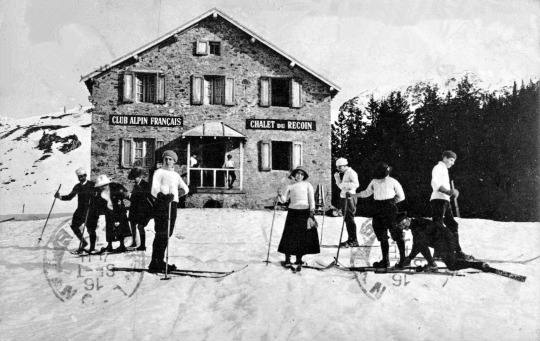
Skieurs au Chalet du Recoin de Chamrousse, Isère.
10 notes
·
View notes
Text

Members of The American Alpine Club at Balcony Camp on Mount McKinley.
Alaska
1959
#vintage camping#campfire light#alaska#american alpine club#mt mckinley#climbing#hiking#adventure#history#camping#1950s
297 notes
·
View notes
Text

The mountains are my safe place
#my post#mountain#photography#sunrise#landscape#switzerland#mountains#Vaud#swiss alps#club alpin suisse#nature hikes#hike#granola girl#nature
25 notes
·
View notes
Text

Pavilion of the Alpine Club on the 1900 Paris World Exhibition
French vintage postcard
#vintage#the alpine club#tarjeta#alpine#briefkaart#postcard#photography#postal#paris world exhibition#world#carte postale#1900#sepia#ephemera#exhibition#historic#paris#french#ansichtskarte#club#postkarte#pavilion#postkaart#photo
12 notes
·
View notes
Text
Norovirus on the PCT . . . How an outbreak spreads along the trail
September 24
By Pien Huang for NPR
I was just corresponding with another PCT-hiking friend about the few times we have felt unsafe on the trail. All of our examples related, not to bears or rattlesnakes or even lightning (I might have included lightning had I thought about it more), to human encounters. A lost soul or two on the trail, hunters combining alcohol and firearms, a camping area near a road. Now here is another thing to worry about . . . norovirus. It is a good reminder not to abandon hygiene in the wilderness. RH

EIS officer Arran Hamlet walks into the Government Meadows site to conduct environmental sampling for norovirus.
Last September, Kevin Quinn was trekking through a remote, mountainous region in central Washington state, when he started feeling sick. "At first, I thought it was just a stomachache," he says, "But when we got to the campsite I started throwing up, and it started coming out the other end as well."
Quinn was on the trail with his daughter, who had left her job so they could hike together. After months of hiking, he found himself wiped out at a campsite in the middle of nowhere.
"I had heard about the norovirus for years, but it was always in the context of 'Oh, there's a cruise ship in the Caribbean,'" he says, "You don't think about this being an issue when you're out on the Pacific Crest Trail."
Norovirus is a highly contagious virus that can cause serious gastrointestinal distress for several days. It's often associated with enclosed, crowded settings like cruise ships, health care facilities and childcare centers.
But it also crops up in the wilderness – like in an outbreak among hikers like Quinn last year which was documented in a recent investigation by the Centers for Disease Control and Prevention.
Call in the disease detectives
After a stream of sick Pacific Crest Trail hikers came through the Washington Alpine Club Lodge near Snoqualmie Pass last summer, a volunteer named Robert Henry closed the dorm-style lodge and emailed health authorities.
"My concern at the time was to make sure that the hikers on the trail didn't get any worse, and to make sure that the volunteers at the Washington Alpine Club didn't contract whatever it was they were bringing in," Henry ways. He also worked to warn other hikers about the threat.

EIS officer Dr. Arran Hamlet observes a water source being tested for environmental contamination of fecal waste and norovirus.
Hamlet focused on a 70-mile stretch of trail south of the Lodge, where ill hikers were coming from. One common rest stop, he learned, was a remote log cabin in the meadows, with a pit latrine and a stream that's used for drinking water.
Hamlet and his team hiked out to the cabin and tested water from the stream. They also swabbed the toilets, the door handles, the tabletops, the poker chips – anything people were touching. While the water samples came back clean, "every single [surface] swab tested positive for fecal contamination," he says.
"This doesn't mean that we can see human feces on things," he adds, "but at some point in time, there was transmission of human fecal contamination onto every surface in the cabin we swabbed, and also everywhere in the latrine."
The results of the investigation were published this month in the CDC's Morbidity and Mortality Weekly Report. Investigators concluded that there was an outbreak of norovirus on the trail last summer that was spreading between hikers and that "exposure to contaminated surfaces within the cabin and ... latrines likely amplified transmission."
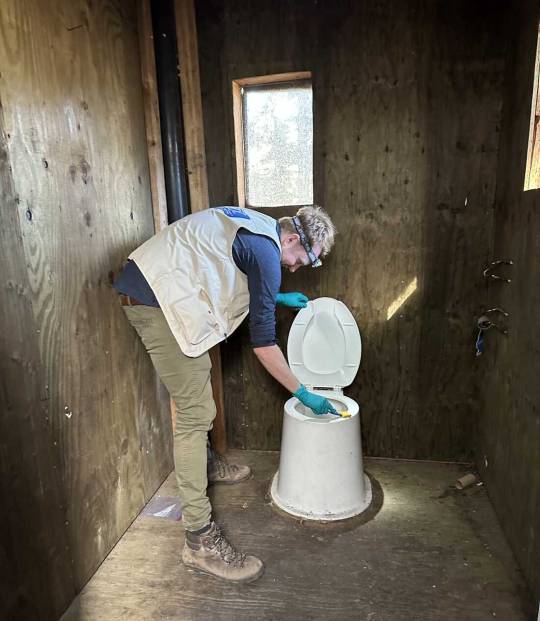
EIS officer Dr. Arran Hamlet swabs a backcountry pit latrine for norovirus sampling during an investigation for an outbreak of gastrointestinal illness among Pacific Crest Trail Hikers in 2022.
Shanna Miko, a nurse epidemiologist at CDC, was part of the field team on the Pacific Crest Trail study — and it wasn't her first norovirus-in-the-woods investigation. Last year, she traced an outbreak at the Grand Canyon, among people who were backcountry hiking and whitewater rafting.
"These are very well-planned trips. For many people, they're once-in-a-lifetime," she says. Travelers often read books and blogs in preparation, and get advice from others who have done the trip before them, accumulating trail wisdom – "places where people frequently stop, or places that have shelters where people frequently sleep over," good places to get water, or use the bathroom, she says.
These hubs, which seem so remote, see thousands of people – in varying levels of wellness – pass through in a season. They may not leave visible traces but some may leave germs, like norovirus, that can live on environmental surfaces for a long time, Miko says. (According to the CDC, this hardy virus can stay alive on surfaces for "days or weeks.")
Hand sanitizer doesn't cut and other advice for staying well
With norovirus, hand sanitizer and common water filters don't work. The virus is small, and "extra sticky" on skin, Miko says. And it takes just a few dozen viral particles to make a person very ill.
Miko says there are ways that hikers can cut their risks.
Always wash your hands with soap and water after you have a bowel movement – and wash them again before you eat. "The soap is a great detergent to remove the virus from your hands," she says. While any soap and water will work, she recommends biodegradable soaps in protected national parks and backcountry woods to reduce the impact on the environment.
Make sure to drink and cook with good, clean water. Pay attention to where the water comes from, and treat it properly. "Boiling for at least three minutes is the best way to kill everything you would typically come across," Miko says. And note: Most water filters are good at removing bacteria and common parasites but they don't cut it when it comes to norovirus. You'll need to layer on either chemical treatment or UV light treatment to kill the virus. (Here's the CDC's breakdown of what works for which pathogens.)
If you do fall ill, shelter in place if you can. This is for your own safety, and for the sake of others, "so you aren't seeding norovirus particles along the trail and putting others at risk," Miko says. This is not the time to try to push ahead but to rest and hydrate. "If possible, try to keep your defecation far from the trail and bury it, and don't prepare food anywhere near where you're using the restroom or vomiting," she says.
The worst of the symptoms usually passes in two to three days, though "you can still spread norovirus after you feel better," Miko says. She recommends waiting at least two days after symptoms have resolved before continuing on.
Norovirus was the last straw

Kevin Quinn set out to hike the Pacific Crest Trail with his daughter, Katie, who had left her job so they could hike together. Norovirus derailed their plans.
He was thirsty, he was really tired – and while he filtered the water, he skipped the additional, chemical treatment. Soon, he knew he'd made a mistake. "I was completely debilitated. I didn't have the energy to set my tent up," he recalls, "All I was doing was, like, every 15 minutes, going off into the woods and either throwing up or having diarrhea."
After a night of being very ill, Quinn and his daughter made a long, slow trek out of the woods. "We never made the whole trail," he says, "We just decided to call it quits."
Earlier in the summer, he caught COVID, which derailed his trail plans for a month. Up ahead, there were wildfires and trail closures. For Quinn, getting norovirus was the last straw.
A year later, he still regrets that he didn't take the time to treat the water properly.
To other hikers – he says: heed the signs, wash your hands and make sure your water is clean. In his experience, it's not worth the risk.
And, we would add, that water treatment options like the Steripen (using UV technology), would seem to be more effective.
9 notes
·
View notes
Text
F1 Book Club









Nobody get offended - just having a little fun. 😉
#f1 book club#f1 memes#ferrari#scuderia ferrari#alpha tauri#alfa romeo#williams#williams racing#rbr#red bull#mclaren#aston martin#alpine#mercedes#f1#formula 1#formula one#haas f1 team#haas
38 notes
·
View notes
Text

Didn't want to post this to Explorers Central because obviously Alpine is not a character in it. She's also not actually related to the Explorers' Realm at all.
Alpine is necessarily a ghost dog that can do the same thing that Koa does. She still is connected to a person. She was a smaller dog when she was alive, but the grim reaper who collected her is a very nice chap and let her live out her alpha wolf dreams (he lets souls assume their internal forms).
Because Alpine is technically a dog (don't call her one to her face though. Or just in general it's not very polite ʘ‿ʘ) she understands dogs better than wolves. I think Koa can do the opposite, converse with wolves clearly but not so much dogs. It's like speaking two relatively similar languages.
Anyway Alpine is so awesome and Koa_Lover is still my Roblox username
#artists on tumblr#art#nye#clip studio paint#digital art#arty art#persona#oc#maladaptive daydreaming#red#mdd#Alpine#Koa#Pbec koa#shadow wolf#the polar bear explorers’ club#tpbec#pbec
4 notes
·
View notes
Text
today is NOT a good day for the french
#esteban dnf and pierre getting bullied by the astons#im not gonna be surprised if they have another loser club#esteban ocon#pierre gasly#alpine#british gp 2023#update: and pierre dnf too :(
7 notes
·
View notes
Text
believing the spanish sport press about random rumours? couldn't be me.
#am i talking about f egy or footie? lmao both#but to the current nonsense:#there is no way in hell that arteta is leaving the club#but also people who take alpine especially esteban related rumours seriously from spanish juornos are so funny
4 notes
·
View notes
Text

C'est le WE... !!
photo ©FFCAM
#mountains#sunset#mountainscape#mountaineering#club alpin#paysage de montagne#haute-montagne#alpinisme#go to the mountains#club alpin francais#refuge#CAF
34 notes
·
View notes
Text
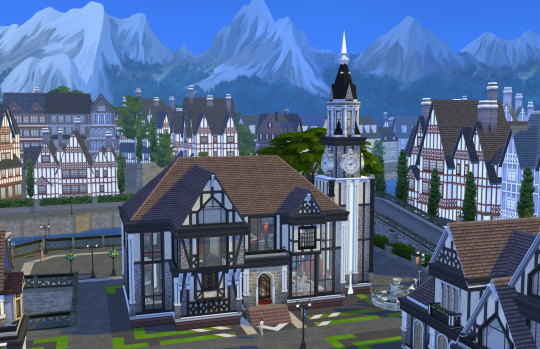
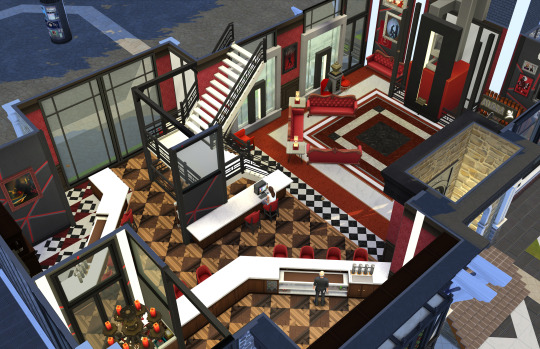


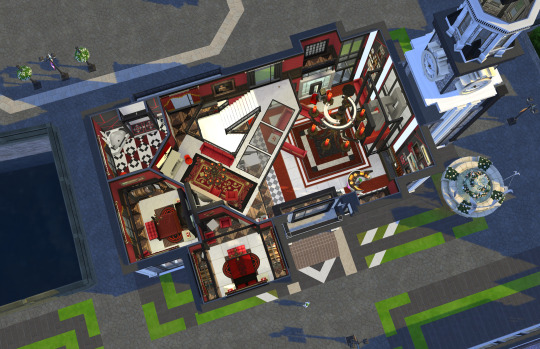

The Narwhal Arms
Origin ID: One_Desy
#windenburg#clocktower#tower#neon#night club#alpine#tudor revival#modern#glass#the sims 4#ts4#no cc#ts4 nocc#sims 4 build#sims4#ts4 builds#game screenshots#sims 4 builds#interior design#traditional architecture#ts4 get together#get together#tudor architecture#modern architecture#architecture
12 notes
·
View notes
Text
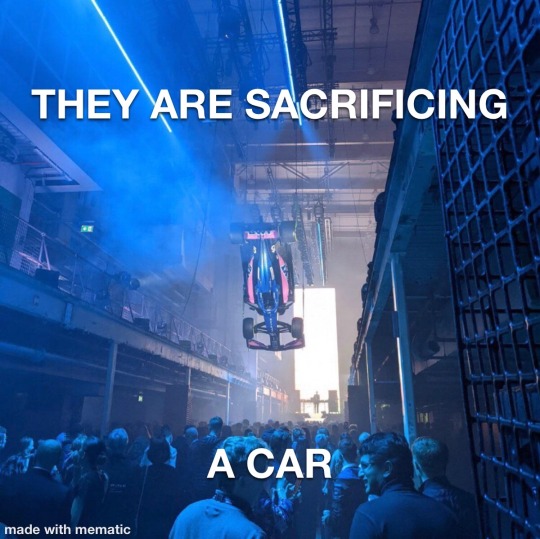
Alpine what sort of marketing is this supposed to be?
5 notes
·
View notes
Text
Ugh I'll cry
ABSOLUTELY LOSING MY MIND OVER THESE TWO

Their story brings me to my knees
#pierre gasly#esteban ocon#alpine#frenchies#formula 1#f1#French civil war#is over?#Ik Kika's gonna have to hear alllll about this tonight#Charles too#he'll george Russell style make a PowerPoint#Este will probably watch spiderman#id like to see pictures of them in the club stat
89 notes
·
View notes
Text

Alpine Club on the 1900 Paris World Exhibition
French vintage postcard
#historic#club#photo#briefkaart#vintage#exhibition#sepia#alpine club#photography#carte postale#paris#postcard#postkarte#postal#tarjeta#ansichtskarte#french#old#ephemera#postkaart#world#paris world exhibition#alpine
5 notes
·
View notes
Text
the secret of us | oscar piastri
summary: after you break up with your boyfriend you start getting closer with a certain mclaren driver, but you’re afraid of what people might say about your new relationship
fc: dina denoire
warnings: ex!age gap, some ugly comments
request: here
a/n: this request is so perfect because gracie has been my hiperfixation since she released her album so i’m dying to write about her songs! also, i chose carlos for the ex since you said you didn’t mind, anything else i hope you like it <3
—

liked by carlossainz55, alexandrasaintmleux and others
yourusername vroom vroom 🏎
view all comments
username the queen is back at the paddock
username i hope you know i’m in love with you
username so beautifuuuul 💗
carlossainz55 hermosa🥰 (beautiful) (liked by yourusername)
username the best wag fr
username face tutorial!
username gorgeous girl 🥵
username stunning 😩

liked by yourusername, charles_leclerc and others
carlossainz55 not a bad start to the season 🏆
view all comments
username last picture goes craaazy
username well deserved podium👏🏽
username carlos in his villain era 😈
yourusername who’s that smooth operator 👀
carlossainz55 🤭
username go king !!!
username calos we can be world champions‼️

liked by oscarpiastri, olliebearman and others
yourusername tourist mode: on 🇮🇹🍝
view all comments
username ugh her !!!
username so gorgeous
bffusername prettiest girl in italy (liked by yourusername)
username did she and carlos broke up?
username ???? why?
username idk she hasn’t been to any gp’s lately and they don’t like or comment on each other posts like they used to
username they also haven’t been seen with each other since the beginning of the year
username they still follow each other tho so idk

liked by f1gossip, oscarpiastri and others
f1wags y/n y/l/n recently with her friends clubbing in milan
view all comments
username she looks so fun 🤩
username does this mean she isn’t going to this weekend’s race either? :(
f1wags doesn’t seem like it since she’s still in italy
username breakup rumors getting louder by the second
username oscar randomly liking this post then unliking? 😭
username he got caught lurking 👀
username if yn and carlos really broke up i’m gonna stop believing in love

liked by francisca.cgomes, oscarpiastri and others
yourusername babylon lovers hangin' lifetimes on a vine
view all comments
username oh no
username 💔💔💔
username wtf does that even mean 😭
username well, taylor wrote it so, you’re probably gonna have to google the meaning
francisca.cgomes face card 🤑
yourusername yours!!!
username omg this song with that specific lyric 😩
username they broke up broke up :(
username hot take but this is probably for the better?? their age gap was weird anyway
username get out of here
username no because who looks like that after a break up 😭
username right??? like she seriously has to be the prettiest woman ever
username guys they unfollowed each other i’m not okay !!!

liked by oscarpiastri, landonorris and others
yourusername i missed this place 🏁 thank you so much mclaren for having me🧡
view all comments
username OMG???
username last thing i ever expected was seeing yn as a mclaren girlie ???
username no cause she has always been the ferrari it girl this gave me whiplash
username never beating the prettiest girl allegations
mclaren it was so nice to have you yn🧡 (liked by yourusername)
francisca.cgomes next time you’re coming to alpine with me!
lilymhe no no no, williams next💙
yourusername i’ll go to every garage at this point 🤣
username the way carlos was at the podium and she didn’t even glance at him once 😭
username and then she was photographed talking to charles and alex 😭😭



liked by oscarpiastri, alexandrasaintmleux and others
yourusername i enjoy walking camden market in the afternoon☕️
view all comments
username yn in her london boy era ???
username and who is the london boy? 🤨
username i just know the breakup did her good she’s glowinggg
username yn in london is all the content i need
bffusername find me a british husband while you’re there
yourusername already networking!
username so pretty💞
username and they call her the it girl

liked by landonorris, yourusername and others
oscarpiastri london for the weekend🍵
view all comments
username he’s sooo boyfriend coded
username last pic made me feel woman things
username omg not him lowkey matching with yn🤭
username first two pics AND both in london⁉️
username coincidence??? or could they be…
username weird way to ask me to marry you but okay
landonorris london boy😎
oscarpiastri not you too🙄
username “you too” ???

liked by alexandrasaintmleux, oscarpiastri and others
yourusername we’re happy free confused and lonely in the best way ❤️
view all comments
username when you’re in a swiftie competition and your opponent is yn
alexandrasaintmleux happy birthday my yn💞
lilymhe happy happy birthday love💘
bffusername 22 years being the prettiest, coolest and kindest soul in the planet🤍
username i can’t believe she’s 22 😭
francisca.cgomes i don’t know about you🫵🏽 but tonight we’re going drinking
charles_leclerc happy birthday, yn!
flavy.barla happy birthday prettyyy💗
landonorris happy bday🥳
oscarpiastri happy birthday🤍

liked by f1wags and others
f1gossip ex-wag y/n y/l/n celebrating her birthday party with her friends and allegedly oscar piastri
view all comments
username allegedly??? babe that’s clearly him
username last thing i expected was to see lando and oscar celebrating yn’s birthday
username 2ND PIC??? 🤭🤭
username they’re so hot
username oscar and yn together was not on my 2024 bingo card
username homie hopper
username are carlos and oscar even friends? 🤣
username i’m sooo invested in this couple
username oscar being always on her likes makes so much sense now
username my man was WAITING for her and carlos to break up to shoot his shot



liked by carmenmmundt, oscarpiastri and others
yourusername so happy to be back at the mclaren garage this weekend 🧡 best birthday present
view all comments
username and she was on oscar’s side of the garage🥹
username petition for mclaren to invite yn to every grand prix (liked by yourusername)
username it still feels weird to see her at mclaren and not ferrari but i’m so happy she’s still going to the races 💕
username am i the only one who finds it weird that she moved on from carlos to oscar that fast?
username yes
username she wants to be a wag so bad 🤣
username or maybe !!! just maybe !!! she’s just living her life and happened to meet a guy she likes who also happens to be a driver, mhhh 🤔
username the way they’re not even official 😭😭 y’all are making up things where there aren’t
oscarpiastri so my present was not the best? 🤨
yourusername close second!

liked by f1gossip and others
f1wags oscar piastri and y/n y/l/n at the grand prix’s after party
view all comments
username cute!
username awww they look good together 🥰
username OSCAR CAN YOU FIGHT
username i don’t understand why people glorify yn so much like she’s clearly a grid bunny it’s gross
username yeah the only reason she’s famous is because she dated a famous guy
username oscar deserves better
username i like them together 💞 they seem happy
username someone needs to save oscar from her 🤮



liked by yourusername, logansargeant and others
oscarpiastri monaco sight-seeing💐
view all comments
username well good morning to you too oscar piastri
username how did he bag a baddie like yn 😭
username by being socially awkward i assume
username forget him i want HER
username he’s really committed to the carlos hate train huh
username adopt me! i can be the fly on the wall!
username yn is stunning 😍
username the only couple ever
yourusername 🥰🥰🥰
oscarpiastri ❤️
#oscar piastri#oscar piastri x reader#oscar piastri one shot#oscar piastri imagine#oscar piastri fluff#f1 x reader#f1#formula one#formula one x reader#oscar piastri x y/n#oscar piastri x you#oscar piastri fanfic#dina denoire#op81#smau#oscar piastri smau#f1 smau#formula 1 smau#social media au#carlos sainz x reader#gracie abrams#the secret of us
2K notes
·
View notes